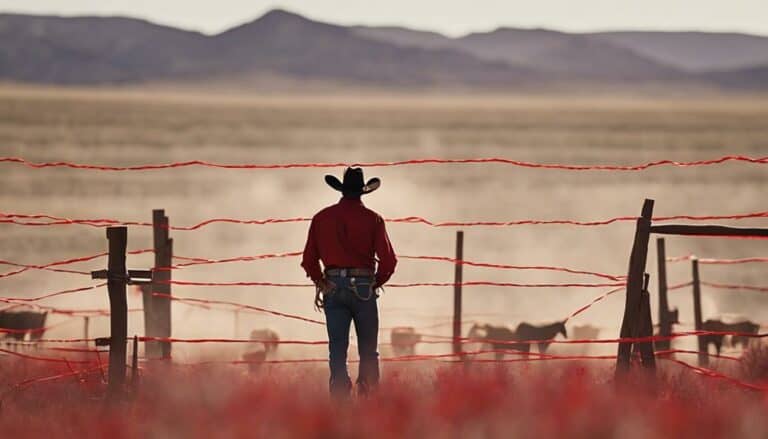Understanding ranching regulations can impact efficiency and profitability. Federal permitting processes and compliance hurdles pose challenges. Red tape delays range improvements and strains operations. Legislation like the Ranching Without Red Tape Act aims to simplify processes. Vulture predation adds financial strain. Streamlining regulations is important for sustainability. Understanding federal permitting and employing strategies are essential. Efficient improvements boost profitability. Balancing efficiency and land protection is key for viability. Initiatives support ranchers. Enhancements in Idaho and Wyoming show benefits. Learn how regulatory changes and strategic approaches can help ranchers confront challenges in the ranching industry.
Key Takeaways
- Federal red tape complicates grazing permit processes for ranchers on federal lands.
- Streamlining regulations through acts like the Ranching Without Red Tape Act is necessary.
- Challenges like permit renegotiations hinder ranching productivity.
- Black vulture predation poses a significant financial threat to livestock producers.
- Efficient regulatory navigation is vital for ranching long-term viability and sustainability.
Regulatory Landscape in Ranching
In the regulatory landscape of ranching, ranchers holding grazing permits on federal lands encounter intricate permitting processes for range improvements. The federal red tape surrounding these grazing permits often leads to delays in permit renegotiations, hindering ranchers' ability to efficiently carry out their work and manage livestock. This bureaucratic burden not only affects the ranchers' operations but also poses challenges for maintaining the health of the land and the well-being of the livestock.
To address these regulatory challenges, legislation such as the Ranching Without Red Tape Act has been introduced to streamline the permitting process. By simplifying regulations and cutting through bureaucratic obstacles, this legislation aims to facilitate timely operations for ranchers, particularly in states like Idaho and Wyoming where ranching plays a significant economic role. Through simplifying regulations, ranchers can focus more on their core activities of managing the land and livestock, ensuring sustainable practices while maneuvering through the complexities of federal permitting processes.
Compliance Hurdles for Ranchers
Compliance hurdles faced by ranchers operating on federal lands stem from the intricate and time-consuming permit renegotiations required for essential range improvements. The permitting process for range improvements can be burdensome, leading to delays in necessary upgrades required for effective livestock management.
Ranchers often find themselves entangled in red tape, struggling to navigate unnecessary regulations that hinder their ability to make timely enhancements to their grazing lands. The Ranching Without Red Tape Act seeks to address these challenges by streamlining regulations and simplifying the permitting process. By eliminating bureaucratic obstacles, ranchers can focus on their work without unnecessary delays.
Simplifying permit renegotiations won't only benefit ranchers but also make sure that range improvements are carried out efficiently, ultimately enhancing the sustainability and productivity of ranching operations on federal lands.
Impact on Ranching Profitability
Dealing with the challenges posed by black vulture predation on livestock is a critical aspect of maintaining profitability in the ranching industry, with financial losses impacting producers greatly. Black vultures attacking livestock, particularly vulnerable animals like newborn calves, lead to significant livestock losses annually, creating a financial strain on thousands of cattle producers in the Southeast and Midwest. The American Sheep Industry Association has identified vulture predation as a major expense for sheep operations, underscoring the widespread impact of black vultures on livestock. The overpopulation of black vultures exacerbates the depredation of livestock, resulting in substantial revenue loss for producers. Managing these losses is paramount for the financial sustainability of livestock operations, emphasizing the need to address this ongoing threat to ranching profitability.
| Key Points | Impact |
|---|---|
| Livestock losses | Significant financial impact on producers |
| Financial strain | Challenges for cattle and sheep operations |
| Revenue loss | Substantial impact on ranching profitability |
Strategies for Regulatory Navigation
Understanding regulatory challenges in ranching requires a thorough grasp of the permitting process for range improvements on federal lands. Efficient ranching operations rely on timely responses from federal agencies regarding improvement requests.
To navigate regulatory hurdles effectively, ranchers can utilize administrative tools such as categorical exclusions to expedite the permitting process. In cases where agencies don't provide timely responses, permittees have the option to proceed with planned improvements.
Streamlining the permitting process not only enhances efficiency but also allows ranchers to concentrate on their work while ensuring proper land protection measures are in place. By employing these strategies, ranchers can better manage regulatory challenges, ensuring that necessary improvements are made promptly and that their operations run smoothly within the bounds of federal regulations.
Embracing these approaches fosters a balance between regulatory compliance and operational effectiveness in the ranching industry.
Ensuring Ranching Long-Term Viability
Achieving long-term viability in ranching necessitates a strategic balance between operational efficiency and land protection measures. Ranching is integral to the traditions and livelihoods of communities in Wyoming, emphasizing the need to balance productivity with sustainability.
Streamlining permitting processes is important for ranchers to focus on their core work without unnecessary regulatory hurdles. Initiatives like the Ranching Without Red Tape Act aim to guarantee timely responses from agencies, supporting ranchers nationwide in managing regulatory challenges.
Making range improvements efficiently and without bureaucratic delays is particularly beneficial for ranchers in states like Idaho and Wyoming, where land use is a critical aspect of ranching operations.
Conclusion
As ranchers continue to navigate the complex web of regulations, the future of the industry hangs in the balance. With profitability at stake, finding innovative solutions to compliance hurdles is essential for long-term viability.
By implementing strategic approaches and advocating for policy changes, ranchers can overcome the red tape that threatens their livelihoods.
The regulatory landscape may be challenging, but with determination and resourcefulness, the ranching industry can adapt and thrive in the face of adversity.

